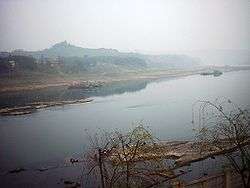Jialing River
| Jialing River | |||||||||
|
The Jialing Basin | |||||||||
| Chinese | 嘉陵江 | ||||||||
|---|---|---|---|---|---|---|---|---|---|
| Literal meaning | Excellent Mound River | ||||||||
| |||||||||
| Former names | |||||||||
|
The Jialing in Hechuan, Chongqing | |||||||||
| Ba River | |||||||||
|---|---|---|---|---|---|---|---|---|---|
| Chinese | 巴水 | ||||||||
| |||||||||
| Lang River | |||||||||
| Traditional Chinese | 閬水 | ||||||||
| Simplified Chinese | 阆水 | ||||||||
| |||||||||
| Yu River | |||||||||
| Chinese | 渝水 | ||||||||
| |||||||||
| Little River | |||||||||
| Chinese | 小河 | ||||||||
| |||||||||
The Jialing River,[lower-alpha 1] formerly known by numerous other names, is a tributary of the Yangtze River with its source in Gansu province.[2] It gets its name from its crossing the Jialing Vale in Feng County of Shaanxi.
The Jialing River's most notable characteristic was formerly its pellucid green waters.[3] It is also notable for its sinuous course. From Zhangwang Miao (Temple of Zhangfei) in Guangyuan to Longdongtuo in Hechuan, the distance as the crow flies is only slightly more than 200 kilometres (120 mi). However the river itself travels over 600 kilometres (370 mi). The most tortuous part of its course is between Nanchong and Wusheng.
Names
The name Jialing did not come into general use until the Tang Dynasty.[4] Before that, it was generally known as the Ba,[4] although it also appears as the Lang and Yu as well. In the 19th century, it was known by the Sichuanese as the Small[3][5] or Little River,[6][lower-alpha 2] by comparison with the Jinsha and Yangtze.
Geography

The Jialing River is 1,119 kilometres (695 mi) long. Its sources were formerly thought to lie in Gansu[3][7] but apparently now lies in Aba Tibetan and Qiang Autonomous Prefecture in Sichuan.[8] The middle course is between Zhaohua and Hechuan. Below Hechuan to where it joins the Yangtze in Chongqing is the lower reaches of the river.
There are large number of tributaries along the Jialing. The largest tributaries include Fu River (also known as Sui He) and Qu River, both of which flow into the Jialing at Hechuan, a small city in Chongqing Municipal area.
The cities along its course include Guang'an, Langzhong, Nanchong, Hechuan, and Chongqing.
Fauna
An amazing total of 151 species of fish inhabit the river, of which 51 species are endemic to the Yangtze River.[9]
History
The Han and Jialing basins were the heartland of the ancient state of Ba, whose major cities were located at the sites of their tributaries' confluences.[7] The Jialing assumed greater importance when Chu expanded up the Han during the 5th and 4th centuries BC.[10]
The Jialing figures in one of the legends surrounding the Tang-era artist Wu Daozi. During the Kaiyuan Era of the Emperor Xuanzong, Wu was commissioned to depict the course of the Jialing and sent to Sichuan to travel its length for the work. Supposedly, he returned to the imperial palace and completed it in a single day from memory.[11][12] It is sometimes added that his technique was foiled by Li Sixun, who accompanied him and followed the traditional practice of working slowly from numerous prepared sketches.[13] To the extent that it is grounded in a real event, however, it probably only reflects Wu's speed of execution and not a lack of reliance on sketches.[14]
Around 1880, four out of Chongqing's 24 shipping guilds were concerned with shipping along the Jialing.[15] Chongqing, Lingshi, Lezhi, and Hechuan all developed shipyards.[16] In the 1920s, five of Chongqing's eight ferry guilds plied routes across the Jialing.[17]
Following the end of the Chinese Civil War in 1949, the river was repeatedly dredged and straightened until it was navigable throughout the year by the early 1970s.[18]
Notes
References
- ↑ "China", Encyclopædia Britannica, 9th ed., Vol. V, 1878.
- ↑ "Jialing River". Encyclopaedia Britannica. Retrieved 12 January 2013.
- 1 2 3 4 Little, Archibald John, Through the Yang-tse Gorges, or, Trade and Travel in Western China, p. 254.
- 1 2 Fan Chengda; et al. (2008), Riding the River Home: A Complete and Annotated Translation of Fan Chengda's Diary of a Boat Trip to Wu (Wuchuan Lu), p. 166.
- 1 2 Parker, Edward Harper, Up the Yang-tse, p. 174.
- ↑ Chabrowski (), p. 103 & 112.
- 1 2 Sage, Steven F., Ancient Sichuan and the Unification of China, p. 54.
- ↑ "Chinese scientists pinpoint source of Jialing River". China.org.cn. 24 January 2014. Retrieved 26 March 2014.
- ↑ "Patterns of Fishes Diversity in Jialing River and Resources Vicissitude in the Middle and Lower Basin". China Papers. Retrieved 12 January 2013.
- ↑ Sage, p. 64.
- ↑ Strassberg, Richard E. (ed.), Inscribed Landscapes: Travel Writing from Imperial China, p. 35.
- ↑ Chen Ju-yen and Late Yuan Painting in Suchou, p. 104.
- ↑ Van Briessen, Fritz (1964), The Way of the Brush: Painting Techniques of China and Japan, p. 52.
- ↑ Kao Yu-kung, "Chinese Lyric Aesthetics", Words and Images: Chinese Poetry, Calligraphy, and Painting, pp. 84–5.
- ↑ Chabrowski, Igor Iwo, Singing on the River: Sichuan Boatmen and Their Work Songs, 1880s–1930s, p. 70.
- ↑ Chabrowski (), p. 72.
- ↑ Chabrowski (), p. 80.
- ↑ "Inland Navigation", Summary of World Broadcasts: The Far East, Weekly Supplement, Pt. 3, 1974, p. 72.
Coordinates: 29°34′16″N 106°34′52″E / 29.5711°N 106.581°E

